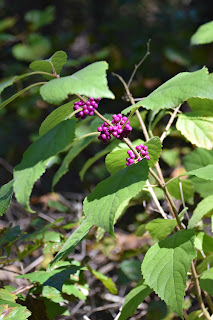The roadside is full of asters now, a bajillion tiny white flowers transforming insignificant green stems into a feast for bees and butterflies at the end of the season. While most people are content to know that these are asters in the Symphyotrichum genus, a few people like to know which species. I worked through the identification of the four most common ones in my area several years ago.
When it comes to explaining these, I want to borrow some
text from Linda
Chafin’s Field Guide to the Wildflowers of Georgia, who likens them to the
botanists’ version of confusing fall warblers:
“No single trait distinguishes any particular species but
taking several traits into consideration can usually lead to a sure
identification.” See page 120-121 of this very excellent book for more.
Another good resource is the Guide
to Vascular Plants of Tennessee (page 449). In general, this resource has
the most complete keys for asters and goldenrod (Solidago) that I’ve found so far, although a species or two may be
missing for Georgia. The challenging thing about using keys is that
the author of the key focuses on a defining characteristic that may not be as
apparent to the rest of us (or at least not without dissecting the flower or
using a better lens). And be prepared to look up words like ‘phyllary’ which is the green bract
underneath the flowerhead; it’s a key concept (literally) in aster
identification.
I am a huge fan of roadside native vegetation and am more
than happy to stop for a few photos and cuttings to figure out what I’m seeing.
When it comes to the roadside white asters, two species seem to be the most
abundant and they are known as the “oldfield” white asters. One has noticeably
fine hairs on the stem and is called the hairy oldfield white aster or frost
aster (Symphyotrichum pilosum) while
the other has less noticeable hairs and is called the smooth oldfield aster or
small white aster (S. racemosum).
 |
| The very floriferous Symphyotrichum racemosum |
Symphyotrichum racemosum is my most abundant aster, taking over one bed almost entirely. The spindly limbs permit the sun to reach through to the spring and summer perennials, allowing it to play fairly well with other plants. Come October, those spindly limbs are transformed into arching stems of small white flowers. Not enough resources talk about how the flowers are largely arranged on one side of the stem but this one does; that is something I always look for when identifying this species. Phyllaries are appressed as you can see in the picture below.
 |
| Symphyotrichum racemosum bracts |
 |
| Symphyotrichum pilosum bracts |
Symphyotrichum pilosum is distinctive among these four if you can get a look at the phyllaries. These small green structures are not appressed in this species, noticeably reflexed away from the flowerhead. There are visible fine hairs along the stems, sometimes giving it a frosted appearance. This species can vary in size depending on the growing conditions available, reaching up to 4 feet tall and wide when favorable. I love to see it popping up in untended fields; look for it now.
 |
| The 'frosted' stems of Symphyotrichum pilosum |
Symphyotrichum dumosum is often called long-stalk aster, a name that points to a trait that can be useful in identifying it (the flowers are held away from the stem, on long stalks). With its appressed phyllaries, it most resembles S. racemosum, but the flowers are larger in size and generally there are fewer of them. Long, thin leaves are also useful when identifying it as they can still be present at flowering time.
 |
| Symphyotrichum dumosum |
 |
| Symphyotrichum dumosum bracts |
 |
| Symphyotrichum dumosum leaves |
Symphyotrichum lateriflorum is named for having flowers along one side (lateriflorum), but, as you may recall, there is another species that has that arrangement: S. racemosum. As mentioned in the earlier reference, S. lateriflorum differs from S. racemosum by having wider stem leaves (I think they are darker green too). In addition, the flowers are generally smaller, and the fresh disk flowers are not bright yellow (more straw-colored) and they age to purple compared to a redder color on S. racemosum. S. lateriflorum has the very charming common name of calico aster.
 |
| Calico aster, Symphyotrichum lateriflorum |
 |
| Symphyotrichum lateriflorum bracts |
I hope this helps demystify some of the more common species. Here are a few more resources that you might use:
The full set of North American asters at the Astereae lab site
(University of Waterloo)
The comparison
of phyllary bracts among American asters at NameThatPlant.net
The SERNEC portal
for finding and viewing scanned herbarium species. SERNEC is the SouthEast
Regional Network of Expertise and Collections

















